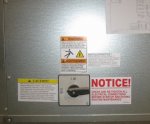- Location
- New Jersey
- Occupation
- Journeyman Electrician
I have fan coil heating/AC units, control panels, motor starters and other equipment with integral disconnecting means under NFPA 70E (which the jurisdiction has not adopted) would these all require a separate disconnect next to the equipment with the integral disconnect if they did adopt NFPA 70E?


